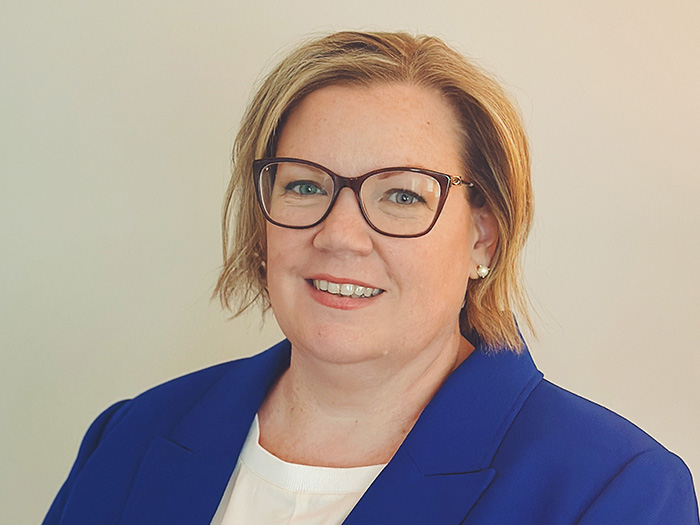Travelers’ Diane Barr On Successfully Insuring Public Sector Exposures, the Risk Management Challenges Small Entities Face and More

As part of our expanded coverage of our 2025 Public Sector Power Broker® winners and finalists, Risk & Insurance® spoke with Diane Barr, vice president and national practice leader for Public Sector Services with Travelers. What follows is a transcript of that discussion that has been edited for length and clarity.
Risk & Insurance: Thanks for talking with us, Diane. What is the key to successfully insuring public sector risks?
Diane Barr: At Travelers, we are committed to helping protect the cities, counties and towns we insure so they can remain focused on serving their communities and constituents. We approach this by first understanding the unique operations of each public entity, enabling us to tailor our offerings based on their specific exposures.
Public entities such as cities, counties, public utilities and transit authorities have distinct risks. Providing coverage options for these unique exposures, including professional liability, property and casualty, is crucial to minimize coverage gaps in the event of a claim.
When I think of what it takes to excel in this space, I envision a three-legged stool comprising underwriting, risk control, and claim resources, and professionals with deep focus in the public sector. For nearly 35 years, Travelers has provided specialized support through our unit dedicated exclusively to underwriting public entities. This dedication allows us to tailor and refine our offerings to help our customers address the new challenges they face every day.
Furthermore, our dedicated claim group has extensive knowledge of immunities, tort defenses and public entities, which is invaluable in adjusting claims effectively. And, in the event of high-profile or high-value cases, our major case unit has the specialized experience to handle them appropriately.
R&I: What role does risk control play regarding public safety for public sector entities?
DB: Given the wide range of areas a public entity practitioner needs to be aware of to keep their city safe, having a dedicated and experienced risk control team can be essential for public entities to help prevent losses from occurring in the first place.
At Travelers, our Risk Control consultants can provide customers with recommendations on various topics such as: ergonomics, industrial hygiene, transportation and fire protection.
R&I: What’s a key characteristic of a successful insurance carrier in the public entity space?
DB: The ability to offer flexible programs that cater to the diverse needs of cities and counties, regardless of their size or where they are on their risk management journey, is so important. At Travelers, for instance, we provide both guaranteed cost and loss sensitive programs.
R&I: What challenges do smaller entities, such as boroughs or townships, face when it comes to risk management, and how can insurance carriers and brokers help address these challenges?
DB: Smaller entities often lack dedicated risk managers or sophisticated risk management resources. This is where insurance carriers and brokers become invaluable in providing the recommendations and safety-related resources.
When an entity purchases insurance from Travelers, they receive more than just coverage. Customers receive access to valuable risk control resources. These are especially beneficial for smaller entities that may not otherwise have access to such resources.
Brokers play a central role in this partnership as well. They can provide additional risk management consulting and expertise to supplement what the insurance carrier offers. The collaboration between the broker, carrier and the insured entity helps ensure that smaller entities have access to the resources they need to help effectively manage their risks.
R&I: What are the key traits of an excellent public sector insurance broker?
DB: They can start by getting to know people in their cities and towns, being out in the public, talking to people, understanding their perspectives and building relationships. This approach requires patience and persistence since it may take a while to court a public entity or get the business, but the patience can pay off as it’s usually a flagship account for the broker.
Getting involved in community or charitable activities is another way for brokers to build relationships. Depending on the state, brokers can also engage with the Public Risk Management Association (PRIMA), which has both national and local chapters. PRIMA provides a good way for brokers to network, get involved with issues important to public entities in that local jurisdiction and gain a wealth of knowledge and information.
Sophistication differs across public entities, and they are really looking for a trusted advisor. A good broker in this space learns the coverages, understands the exposures and builds that brand of being a knowledgeable person who can help clients through their insurance purchasing process, which is incredibly helpful to any public entity.
R&I: What role do politics and relationships play in securing business as a broker in the public sector?
DB: Relationship-wise, it’s not just about the immediate transaction, but fostering long-term connections. Navigating the political landscape requires patience, finesse and understanding the various stakeholders involved.
While politics may play a role in securing new business opportunities, I see it more as a changing of the guard. When new council members join, you might have a relationship with one of them because they’re your neighbor, which provides a new opportunity to discuss how you could potentially help the city or county.
Ultimately, success in this arena comes down to establishing trust, demonstrating value and consistently delivering results over time. It’s a marathon, not a sprint, and those who can effectively manage the political and relational aspects will have a distinct advantage.
R&I: What geographic nuances or differences should brokers be aware of when trying to secure and succeed in public sector business across different regions of the country?
DB: Two differences that I’ll touch on are weather and the carrier competitive landscape.
The geographical location of a public entity affects the weather-related risks they’re most vulnerable to, whether it’s severe convective storms, hurricanes, hail, tornados or wildfires. And because public entities usually have a large concentration of risk in a particular area, a single event like a tornado can impact many buildings at once.
With the increasing frequency of severe weather, it’s especially important for brokers to understand the nuances around the differing local property markets, and be able to discuss these dynamics with their clients.
Agents and brokers need to adeptly navigate and understand the carrier competitive landscape in the regions they serve. This can include regional and national carriers as well as the local pools, which are unique to the public sector. They also need to recognize that the programs and coverage nuances can differ significantly between states, even neighboring ones.
R&I: What are the most critical insurance lines for a public sector customer?
DB: For public sector customers, all insurance lines are critical due to their diverse and broad operations. While property, auto and general liability (GL) are essential, the exposures within these lines are unique for public entities.
GL coverage is different because public entities run programs like parks and recreation, after-school care and athletic departments, which deal with kids. They also handle street and road maintenance and emergency medical response.
Auto exposure is significant due to high-hazard vehicles like fire trucks, snowplows and police cars equipped with advanced technology. Parking these vehicles together in one location also poses a risk.
Property coverage is crucial, considering the high concentration of structures and historic buildings that are difficult to value and replace if damaged.
Additionally, there are coverages specific to public entities, such as law enforcement liability, public entity management liability, employment practices liability and cyber liability. Public entities have long been targets for bad actors in the cyber realm.
Understanding these exposures, matching coverage and terms to them, offering risk control measures to mitigate losses, and adjusting claims appropriately are all essential. It can be daunting for brokers who are new to writing public entity business, but working with knowledgeable carriers and seeking education through organizations like PRIMA can help them gain the necessary expertise to confidently pursue this business.
R&I: How does Travelers support brokers and agents who may not have extensive experience in writing certain types of insurance?
DB: By collaborating closely with our specialized team, brokers can enhance their value proposition and differentiate themselves in the market. Our knowledge and experience enable us to guide brokers in navigating complex risks and developing comprehensive risk management strategies.
We have a dedicated group of territory managers in the field whose primary role is to assist brokers and agents in partnering and educating. They are readily available to accompany brokers when presenting proposals or providing any necessary support.
This hands-on approach is part of our daily commitment to our agent and broker partners. Our goal is to ensure that if they feel even slightly uncomfortable, we can leverage our relationship and expertise to help them gain the knowledge they need to feel confident.
We’ve also developed additional resources to help brokers build their practice within the public sector – it’s what we call Sound Advice for Savvy Agents. Through an in-depth guide and two-part video series available on the Travelers website, we introduce the fundamentals for success, from networking to prospecting and ongoing account service.
By partnering with us and tapping into our expertise, brokers can position themselves as trusted advisors and industry leaders. We value our agent and broker relationships, and work to empower them to deliver superior service to their clients, strengthen their relationships and drive business growth.
R&I: What are the key differences in the purchasing process for public sector entities compared to private sector commercial risks?
DB: When working with public sector entities, agents and brokers need to understand the specific purchasing requirements. Some entities are legally mandated to open bids every set number of years, necessitating a request for proposal (RFP) or bid proposal process.
In certain cases, they may even issue an RFP for broker services, meaning that to become their broker, one must participate in the RFP. State laws can also dictate how often public entities must open bids, adding another layer of complexity.
The decision-making process varies among entities. Some open all bids at once and review them together, while others allow brokers to present the bids and their recommendations to the council before a vote. Understanding these nuances is key for brokers aiming to secure the business.
Ultimately, to be successful, brokers must grasp the purchasing process, identify the decision-makers and strategically present their case to the right individuals. This may involve getting in front of the council, the risk manager or whoever holds the authority to approve the business.
R&I: What emerging risks in the public sector should be closely monitored?
DB: One risk impacting public entities is stressed budgets, which places added pressure on civic employees who are already wearing multiple hats. They may, for example, ultimately find themselves balancing priorities between investments in infrastructure with budgetary constraints.
Another broad category of emerging risk that requires close attention in the public sector is mental health.
First responders often encounter incidents involving individuals with mental health issues, which adds complexity to their work. It’s crucial that they are well trained and equipped to assess these situations and bring the right resources to bear.
Secondly, the nature of their work exposes first responders to heart-wrenching and jarring scenarios. It’s essential to ensure that they have access to the care they need to cope with these experiences.
In a recent Travelers proprietary survey of public sector employees, we found that most public entities are investing in mental health services for first responders, such as therapy, training, education and peer-to-peer support.
In the past, people were more reluctant to admit to seeking therapy. However, attitudes are changing, and there’s a growing recognition of the importance of mental health support, particularly for first responders. New ideas continue to emerge around how to approach this issue and raise awareness. &










